The face, a canvas of both biology and experience, tells stories long before words are spoken. One feature that has garnered increasing attention from both dermatologists and mental health professionals alike is the chin crease—particularly the horizontal indentation known as the mental crease. While often regarded as a simple sign of aging, the mental crease may reflect a more nuanced interplay between facial anatomy, emotional states, and even chronic muscular tension. This crease, which typically appears between the lower lip and the top of the chin, is now at the intersection of cosmetic dermatology and psychological insight, prompting new questions about what lies beneath the surface of our skin.
You may also like: How to Choose Skin Care for Fine Lines: Evidence-Based Tips for Healthier, Younger-Looking Skin
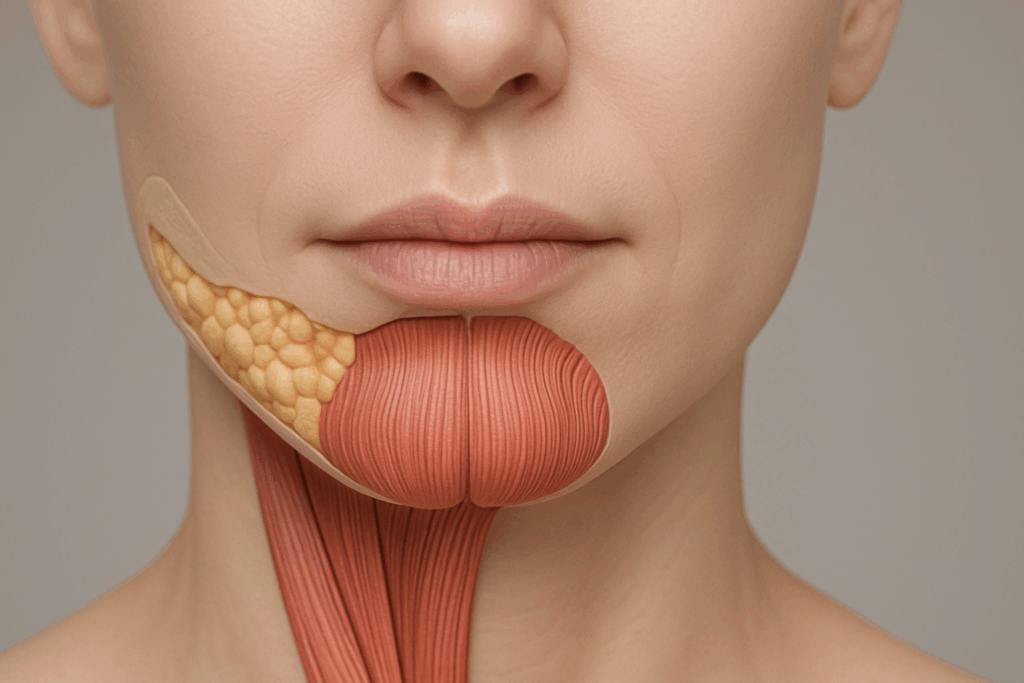
The Emergence of the Mental Crease: Anatomy, Aging, and Expression
From a purely anatomical perspective, the mental crease arises from the dynamic interaction between the mentalis muscle and the surrounding subcutaneous fat and dermal structures. Over time, repetitive movements, such as pursing the lips or tensing the lower face during moments of stress or concentration, can deepen this line. Genetics also plays a pivotal role. Some individuals are predisposed to developing a chin crease earlier in life, while others may never see a pronounced fold.
But age remains the most common contributor. As collagen levels decrease and skin loses elasticity, structural changes around the chin become more visible. The lower third of the face tends to sag with time, leading to a more defined crease that may seem etched permanently into the skin. For many people, this development can be a source of cosmetic concern, especially as it subtly alters facial harmony.
What complicates the story of the mental crease is that it’s not solely a cosmetic issue. Some experts have posited that this specific line, more than others, may serve as a somatic mirror for prolonged emotional strain. Similar to how frown lines are associated with frequent expressions of disapproval or worry, the mental crease could reflect habitual clenching or lower facial tension developed in response to internalized stress.
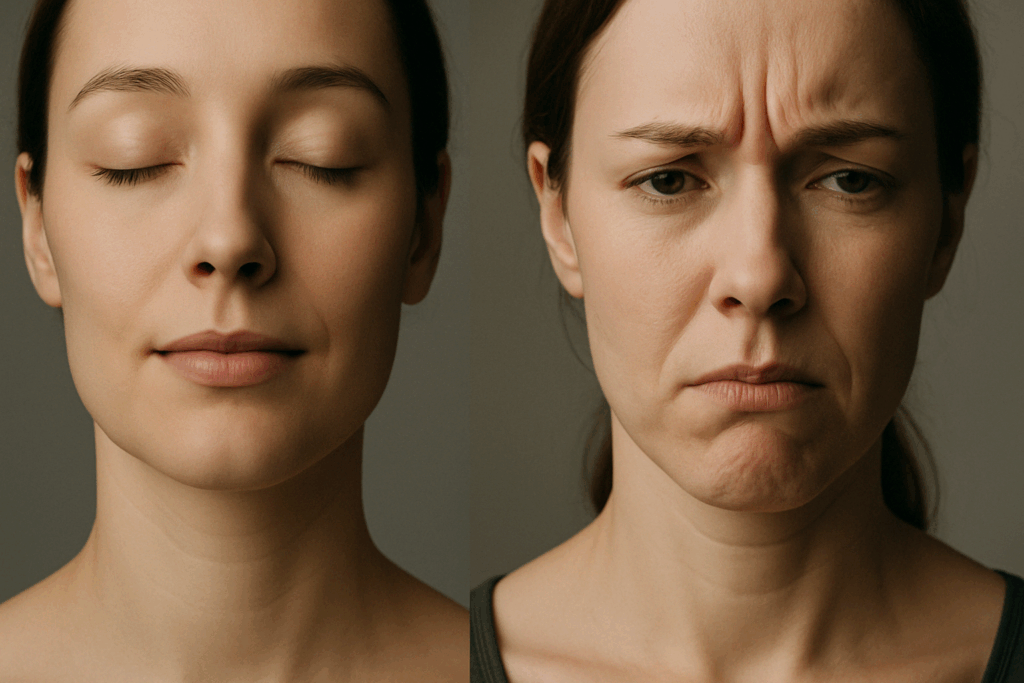
Can You Get the Line on Your Chin from Stress or Emotion?
The question often asked in both dermatological consultations and aesthetic forums is, “Can you get the line on your chin from stress?” The answer appears to be more complex than a simple yes or no. While structural aging is undeniable, a growing body of anecdotal evidence and clinical observation supports the idea that psychological stress can contribute to facial changes—and not just through indirect effects like sleep disturbance or hormonal shifts.
Facial muscles, like all muscles, respond to neural input. Chronic stress activates the sympathetic nervous system, prompting muscular tension throughout the body, including the face. Over time, individuals who habitually tense their lower jaw or compress their lips may unintentionally engrain these patterns into their appearance. The chin crease, in this context, may become a physical manifestation of an emotional state.
Moreover, individuals with anxiety or high levels of conscientiousness often display more control over facial expressions, sometimes suppressing emotions rather than expressing them. This subtle tension can lead to persistent micro-movements, particularly in the mentalis region, which in turn contributes to deepening the line on the chin. Therefore, while not the only factor, stress-related muscle engagement certainly plays a role in how and when the mental crease forms.
Decoding the Mental Crease: Cosmetic Implications and Emotional Significance
Unlike nasolabial folds or crow’s feet, which have long been associated with smiling and laughter, the mental crease has a more ambiguous emotional narrative. Its appearance may unintentionally suggest sadness, sternness, or fatigue, even when none is present. This can affect interpersonal dynamics, as facial expressions play a vital role in nonverbal communication.
Psychologically, individuals who develop a pronounced mental crease often report a mismatch between how they feel internally and how others perceive them. They may be told they look tired, serious, or even upset when they are not. This feedback loop can affect self-esteem, social confidence, and emotional well-being. In essence, a chin crease can become more than a skin-deep issue; it can shape personal identity and self-image.
Dermatologists and cosmetic physicians are becoming increasingly aware of this dual role. Addressing the mental crease is no longer just about smoothing a line—it’s about restoring congruence between internal emotional states and external presentation. In this way, aesthetic interventions may support not just appearance, but also psychological health.
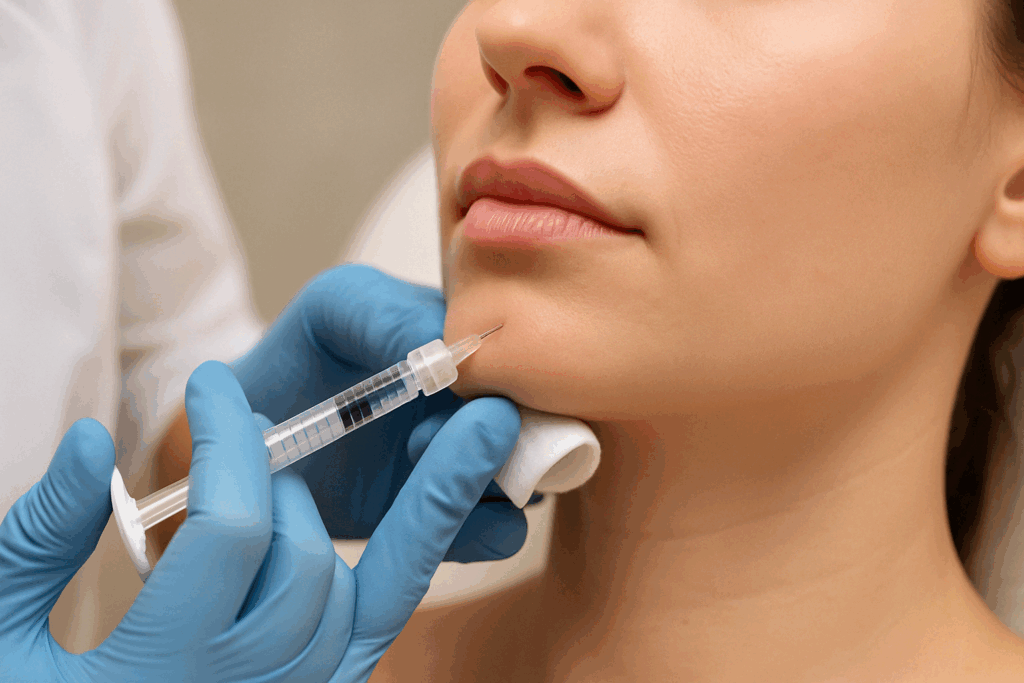
The Rise of Mental Crease Filler: Techniques, Benefits, and Considerations
As non-surgical cosmetic procedures continue to evolve, the use of dermal fillers to address the mental crease has gained traction. Mental crease filler involves the careful injection of hyaluronic acid or similar substances into the groove between the lower lip and the chin to restore volume and soften the line’s appearance. The goal is to create a smoother, more balanced facial contour without compromising natural movement.
This treatment is often performed as part of a broader facial harmonization strategy, sometimes combined with chin augmentation or lip enhancement. It is especially appealing to individuals seeking minimally invasive solutions with immediate results. However, it is crucial to approach this procedure with both anatomical precision and psychological sensitivity. The area around the chin is rich in nerve endings and dynamic musculature, making proper technique essential for both safety and aesthetic outcome.
Patients considering mental crease filler should be guided by a practitioner who understands not only the technical aspects of injection but also the underlying emotional motivations. Many individuals are drawn to this procedure not out of vanity, but out of a desire to align their appearance with their internal emotional experience. For some, smoothing the chin crease represents a small but meaningful act of reclaiming agency over how they are perceived.
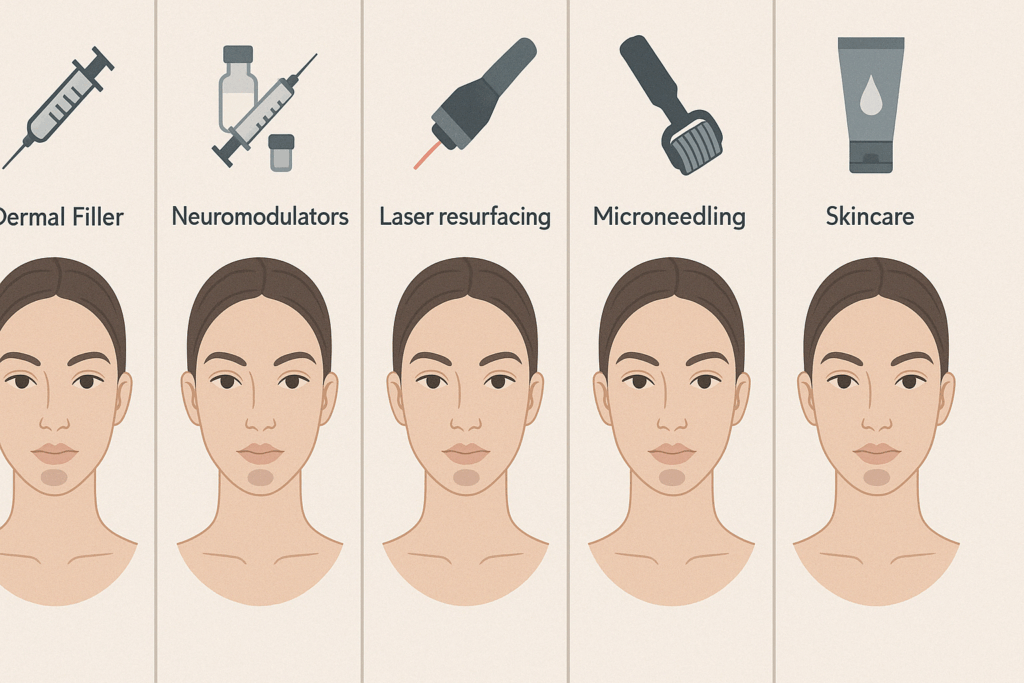
Is Mental Crease Filler Right for Everyone?
Not everyone with a chin crease will benefit from or require filler. The decision depends on multiple factors, including the depth of the crease, the degree of volume loss, facial proportions, skin thickness, and, most importantly, personal goals. A comprehensive consultation with a board-certified dermatologist or aesthetic physician is essential to determine the most appropriate approach.
Some cases may benefit more from skin resurfacing procedures like laser therapy or microneedling, which stimulate collagen production. Others may find that neuromodulators, such as botulinum toxin, can help reduce overactivity in the mentalis muscle, softening the crease without adding volume. In still other cases, the mental crease may be a natural feature that does not warrant correction.
Moreover, psychological readiness is key. Patients should have realistic expectations about what filler can and cannot do. While it can certainly enhance appearance and even improve emotional well-being by reducing perceived facial tension, it is not a substitute for deeper psychological work. Cosmetic interventions should ideally be integrated into a holistic self-care strategy that includes attention to mental health.
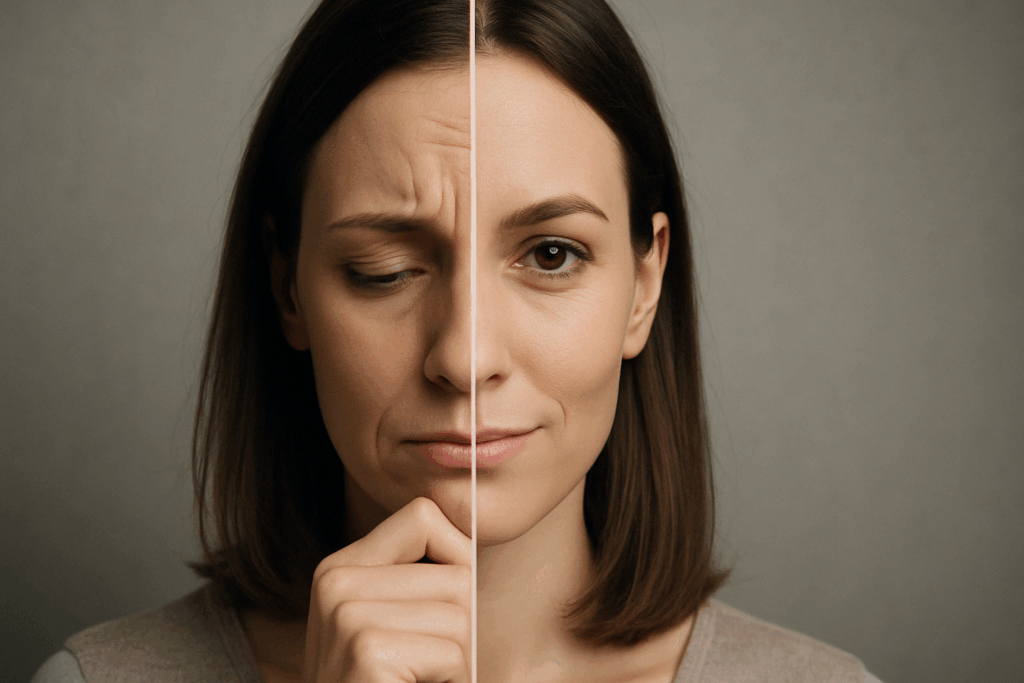
Mental Health and Facial Appearance: A Biopsychosocial Perspective
Modern medicine increasingly recognizes the interconnectedness of mind and body. Nowhere is this more evident than in the study of how facial features reflect emotional well-being. The chin crease, though subtle, is one such indicator. Its formation and perception are influenced by a confluence of biological aging, emotional expression, social feedback, and even cultural norms around beauty and aging.
From a biopsychosocial standpoint, addressing the chin crease becomes more than an aesthetic endeavor. It becomes an opportunity to explore the relationship between self-image and mental health. Individuals who undergo filler treatment for a pronounced mental crease often report improvements in mood, confidence, and social interaction—not because the filler itself changes their personality, but because it helps restore a sense of congruity between how they feel and how they appear.
Of course, this does not mean that everyone with a mental crease is suffering emotionally, nor that all lines must be treated. But for those who feel a disconnect between their external and internal states, aesthetic treatments can be one component of a larger therapeutic journey. In this context, dermatology and mental health are not separate silos but complementary domains.
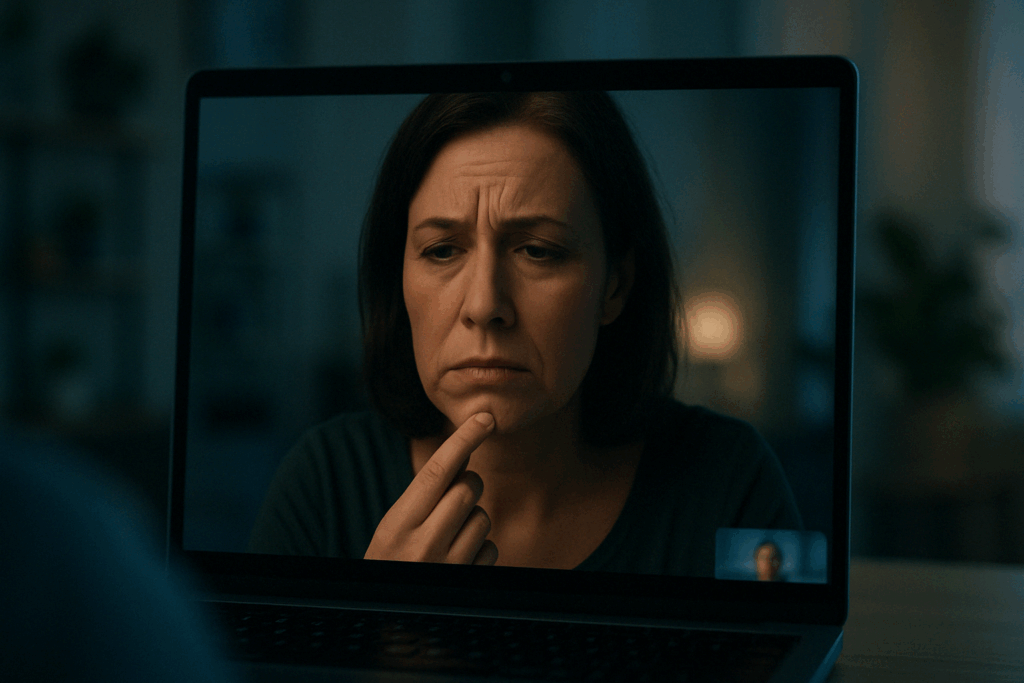
Social Perceptions and the Emotional Toll of Facial Lines
In a culture increasingly dominated by visual media, the face has become a primary site of identity. Photos, selfies, and video calls now play a larger role in our social and professional lives than ever before. As a result, subtle changes in facial appearance—including the development of a chin crease—can have disproportionate psychological effects.
People may become hyper-aware of their appearance on screen, noticing features they had previously overlooked. The line on the chin, especially when deep or shadowed by certain lighting, can appear more pronounced on digital platforms. This can trigger or exacerbate concerns about aging or attractiveness, particularly among individuals in high-visibility professions or social environments.
Moreover, others may interpret the presence of a chin crease through a subconscious lens, attributing personality traits based on facial cues. Although this perception is rarely intentional, it can still influence interpersonal dynamics. A person with a pronounced mental crease may be misjudged as serious or unapproachable, even if their demeanor says otherwise.
This phenomenon highlights the broader implications of facial aesthetics. The decision to seek mental crease filler, in this light, is not simply about vanity but about navigating a world where appearance affects experience. The goal is not to erase all signs of aging or emotion, but to create a sense of harmony between appearance and identity.
Integrating Aesthetic Interventions with Emotional Wellness
A growing number of aesthetic practices now incorporate psychological assessments into their treatment planning. Practitioners trained in both cosmetic procedures and mental health screening can offer a more integrative approach, ensuring that patients pursue aesthetic changes for the right reasons and with the right expectations.
When it comes to mental crease filler, such integration is especially important. Because the crease itself may reflect underlying emotional tension or chronic stress, addressing it should include conversations about lifestyle, coping strategies, and mental well-being. Patients who understand this broader context are more likely to be satisfied with their results and less likely to pursue repeated or unnecessary treatments.
For some, this might involve mindfulness practices to reduce facial tension. For others, therapy may help resolve the emotional stress that initially contributed to the crease. By pairing physical treatments with psychological insight, patients can experience more holistic and lasting improvements in both appearance and well-being.

The Role of Preventative Care in Chin Crease Formation
Prevention is often more effective than correction when it comes to facial aging. Understanding the factors that lead to the development of a chin crease can help individuals take proactive steps to preserve skin integrity and facial balance. Hydration, sun protection, and a consistent skincare routine that includes retinoids or peptides can all support collagen health and elasticity.
Facial exercises that promote balanced muscle engagement may also be beneficial, particularly for individuals who are prone to habitual clenching or tension in the jaw. Additionally, stress management techniques such as yoga, meditation, or biofeedback can help reduce the facial tension that contributes to the line on your chin.
Lifestyle choices, including nutrition and sleep quality, also influence the aging process. A diet rich in antioxidants, healthy fats, and amino acids supports skin health from the inside out. Meanwhile, sufficient restorative sleep gives the body time to repair and regenerate, including the delicate tissues around the mouth and chin.
By combining these preventive strategies with professional care, individuals can slow the development of the mental crease and maintain a more youthful and expressive appearance without relying solely on cosmetic procedures.
Reframing the Chin Crease as a Window Into Emotional Health
While the term “mental crease” may suggest a purely anatomical feature, its implications reach further. For many, this line becomes a focal point not just of aesthetic concern, but of emotional reflection. It invites questions about how we carry our stress, how our faces tell our stories, and how we choose to shape those narratives.
In some ways, the crease represents a psychological landmark—a place where internal experience meets external form. Addressing it through filler, skincare, or lifestyle change is not a denial of aging or emotion, but a conscious choice to navigate their visible signs in a way that feels empowering.
Ultimately, the decision to treat a chin crease is deeply personal. For some, it may be a welcome reminder of resilience and life lived. For others, it may feel like an unwanted burden that distorts how they are seen. In either case, the conversation about mental creases must be both compassionate and comprehensive, acknowledging the complexity behind a seemingly simple line.
Aesthetic medicine, when practiced with empathy and expertise, has the potential to do more than improve appearances. It can offer a form of care that supports psychological integration, social ease, and self-acceptance. And in the case of the mental crease, that potential is especially profound.
Frequently Asked Questions: Chin Creases, Mental Creases, and Filler Insights
1. Can stress really lead to a noticeable line on your chin over time?
Yes, chronic stress can play a significant role in the development of a visible line on your chin. This is particularly evident in individuals who unconsciously clench their jaw or tighten their facial muscles in response to anxiety or emotional strain. Over time, repeated tension in the mentalis muscle contributes to the formation of a persistent chin crease. While genetics and aging are primary factors, stress accelerates these changes by reinforcing muscular habits that create creases. Therefore, when asking “can you get the line on your chin from stress,” the answer is a well-supported yes—emotional states absolutely influence physical appearance.
2. Is the mental crease considered a clinical concern or purely cosmetic?
The mental crease is generally not a medical issue unless it accompanies other dermatological or muscular conditions. However, its implications extend beyond aesthetics. For some, the mental crease affects self-esteem and may be perceived as conveying unintended emotions like sadness or fatigue. In therapeutic contexts, patients sometimes report that their chin crease makes them feel disconnected from their youthful identity or internal emotional state. Thus, while it isn’t a clinical disorder, the mental crease holds psychological weight that can warrant professional attention from both aesthetic and mental health practitioners.
3. Are there non-filler alternatives to address the appearance of a chin crease?
Yes, there are several non-filler options for managing the appearance of a chin crease. These include laser resurfacing, microneedling, radiofrequency therapy, and the use of prescription-strength retinoids to stimulate collagen remodeling. In cases where muscle activity plays a major role, neuromodulators like botulinum toxin can be injected to relax the mentalis muscle, preventing further creasing. For people hesitant about mental crease filler, these alternatives offer varying degrees of improvement, particularly when combined with good skincare and lifestyle adjustments aimed at reducing facial tension.
4. How long do results from mental crease filler typically last, and are there risks?
Mental crease filler results usually last between six to twelve months, depending on the type of filler used, the depth of the crease, and individual metabolic factors. As with any cosmetic procedure, there are risks including swelling, bruising, asymmetry, or rare vascular complications. Choosing a board-certified injector with anatomical expertise significantly reduces these risks. While most patients tolerate chin crease fillers well, periodic touch-ups are often needed to maintain results. Informed decision-making and proper aftercare are crucial for ensuring both safety and satisfaction.
5. Can you get the line on your chin even if you’re young and healthy?
Absolutely. While chin creases are more common with aging, younger individuals can develop them too, particularly if they have strong mentalis muscle activity or a natural predisposition due to facial structure. Athletes and musicians, for example, often engage the lower face frequently, which can deepen the crease over time. Even habitual expressions like pouting or frowning can contribute. So yes, you can get the line on your chin regardless of age, especially if muscle movement and facial tension are frequent.
6. Does filler in the mental crease ever look unnatural or overdone?
When performed correctly, mental crease filler should look smooth and subtle. Problems arise when too much volume is added or when filler is placed too superficially, leading to lumps or puffiness. In some cases, overcorrection can distort the natural curvature of the chin or interfere with normal expression. That said, skilled injectors use conservative volumes and proper techniques to avoid these pitfalls. To ensure a natural outcome, it’s essential to seek providers who specialize in facial anatomy and have experience treating the mental crease specifically.
7. Are there ways to prevent a chin crease from forming in the first place?
Yes, prevention strategies can delay or minimize the development of a mental crease. These include maintaining skin elasticity with sun protection, adequate hydration, and collagen-boosting topicals like peptides and vitamin C. Reducing chronic jaw tension through massage, stress management, or biofeedback therapy also helps prevent repetitive muscle contractions. Practicing mindful facial expressions and minimizing overuse of the mentalis muscle may reduce stress on the skin in this area. While aging is inevitable, consistent preventative care can significantly impact how and when a chin crease develops.
8. How does the presence of a mental crease affect digital or photographic appearance?
In digital media, chin creases often become exaggerated due to shadows and lighting angles, especially in selfies or video calls. This visual distortion can make the mental crease appear deeper or more prominent than it looks in person. As a result, individuals may feel more self-conscious, particularly in virtual settings where facial details are scrutinized closely. Even subtle lighting can accentuate the line on your chin, prompting people to seek aesthetic solutions or camera filters to minimize it. Awareness of these dynamics has led many to consider mental crease filler as part of their digital self-presentation strategy.
9. Are there cultural or psychological factors that influence how we perceive chin creases?
Yes, cultural ideals about aging, attractiveness, and emotional expression heavily influence how chin creases are perceived. In societies that value youthfulness and emotional transparency, a prominent mental crease may be interpreted negatively, even subconsciously. Some cultures may associate such features with wisdom or maturity, while others view them as undesirable signs of aging or stress. Psychologically, individuals may internalize these judgments, developing concerns about how their mental crease affects their social presence or personal identity. Understanding these nuances helps contextualize why some people feel strongly about seeking mental crease filler, even for a relatively minor line.
10. Could future technologies change how we treat or understand the chin crease?
Emerging technologies in regenerative medicine, such as biostimulatory fillers and exosome-based treatments, may soon offer longer-lasting or more natural ways to improve chin creases. Personalized 3D facial mapping could also allow for ultra-precise targeting of volume deficits in the mental crease without disrupting surrounding tissue. Meanwhile, neuroaesthetic research is shedding light on how facial symmetry and expressions affect emotional recognition, potentially redefining how the chin crease is perceived. These innovations may not only improve the efficacy of mental crease filler but also broaden our understanding of how the line on your chin intersects with emotional health and self-expression.
Embracing a Holistic Approach to Chin Creases and Mental Crease Filler
In the end, the mental crease stands as a reminder that our faces are living records of both biology and biography. As we age, it is natural for our features to evolve. But the emergence of a chin crease does not have to signal a loss of vitality or expressiveness. Instead, it can be an invitation to engage more consciously with our emotional and physical well-being.
For those considering mental crease filler, the key is not just to smooth a line but to explore what that line means. Does it reflect stress, inherited traits, or lifestyle patterns? Is it something that feels at odds with your self-image, or a feature that tells a meaningful story?
With the right guidance, patients can make informed decisions that honor both their appearance and their inner life. Whether choosing to treat the crease or embrace it, the goal is authenticity—an alignment between how we look and who we are. And that, more than anything, is the true mark of beauty.
By understanding the full context of chin creases—including anatomy, emotion, perception, and treatment—we gain a more nuanced view of aging and self-care. We begin to see that the question isn’t just “can you get the line on your chin?” but rather, “what does the line on your chin mean to you?” In answering that, we take a step toward more compassionate, holistic health and wellness.
Was this article helpful? Don’t let it stop with you. Share it right now with someone who needs to see it—whether it’s a friend, a colleague, or your whole network. And if staying ahead on this topic matters to you, subscribe to this publication for the most up-to-date information. You’ll get the latest insights delivered straight to you—no searching, no missing out.
Further Reading:
Mental Crease (Chin Wrinkles) Prevention And Treatment
Treating the Mental Crease & Preventing Upwards Rotation
How to Get Rid of Mental Chin Crease Naturally
Disclaimer
The information contained in this article is provided for general informational purposes only and is not intended to serve as medical, legal, or professional advice. While Health11News strives to present accurate, up-to-date, and reliable content, no warranty or guarantee, expressed or implied, is made regarding the completeness, accuracy, or adequacy of the information provided. Readers are strongly advised to seek the guidance of a qualified healthcare provider or other relevant professionals before acting on any information contained in this article. Health11News, its authors, editors, and contributors expressly disclaim any liability for any damages, losses, or consequences arising directly or indirectly from the use, interpretation, or reliance on any information presented herein. The views and opinions expressed in this article are those of the author(s) and do not necessarily reflect the official policies or positions of Health11News.